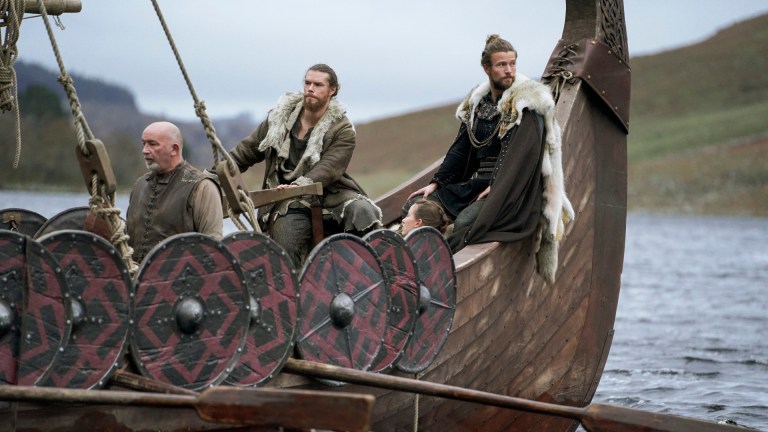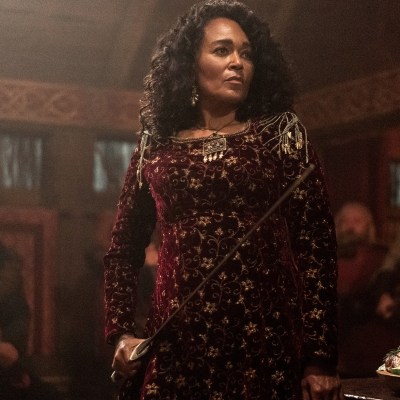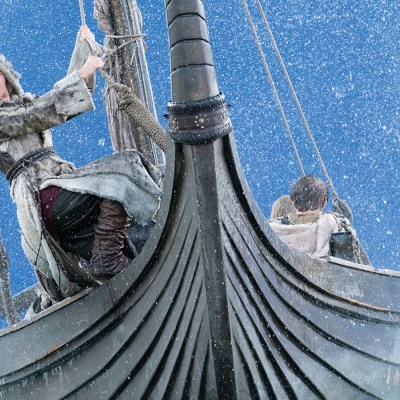The Road to Valhalla: A Vikings Timeline
Here are the important Vikings events to know in advance of Vikings: Valhalla

This article contains spoilers for Vikings.
Vikings brought to life the sagas of Ragnar Lothbrook and his progeny. The series’ sweeping, twisting, end-of-empire narrative – blending history with legend, fact with fiction, blood with water, war with peace – chronicled the fate of the Viking people as they fought to understand the world and their place within it, which was diminishing even as it seemed their horizons were broadening.
By the finale it was clear that the scattered, conquistadorial peoples of Scandinavia were facing the erosion and erasure of both their gods, and their whole way of life. Despite the gloom, the series ended on a note of hope for the future, celebrating the Vikings’ capacity for change, reinvention and, perhaps most surprisingly of all, love.
Netflix’s new sequel series, Vikings: Valhalla, set a hundred or so years later, reminds us that the story didn’t end with Ragnar. The Vikings changed, but they weren’t yet ready to stop being Vikings.
But before gazing upon the new (old) world, Den of Geek decided to look back at the ten most significant events in the Vikings timeline, and remind ourselves from whence history’s favorite marauders and warrior philosophers came. Then we can more readily ask where they might be going.
793 A.D. – Go West
The visionary farmer-turned-Viking Ragnar Lothbrook defies the pronouncements of Earl Haraldson by leading an expedition westwards into uncharted territory, using a boat built by his life-long friend, Floki. Ragnar’s party reaches the British Isles and sacks Lindesfarne, igniting long-standing hostilities with the Saxon people. Ragnar spares the life of the Christian Saxon monk Athelstan, taking him back to Kattegat to serve as a living witness to Viking society, and its plurality of gods. Athelstan’s Christianity, though reviled as an alien contagion by the populace, is slowly absorbed into Ragnar’s soul as the two men become friends. This cultural exchange presages the religious conflicts, changes and confusions to come later in the series, and especially in Vikings: Valhalla.
794 A.D. – Saxon, Sax-off
Ragnar is now the Earl of Kattegat, having supplanted Earl Haraldson in a duel to the death. Ragnar, emboldened by his early success plundering the Saxons, leads a raiding party of Vikings westward to the Saxon kingdom of Northumbria, where his warriors meet and defeat the forces of King Aelle in battle. The capture and execution of King Aelle’s brother sets in motion a chain of events that will lead eventually both to Ragnar’s demise, and the Saxons’ greatest nightmare.
800 A.D. – Hail to the King
Ragnar and Danish King Horik join forces and set out for Wessex. This time, the Saxons are prepared for the Vikings. Ragnar and his warriors are defeated in battle by the combined forces of King Aelle and King Ecbert. In a bid to deter future Viking incursions and cement the fragile peace, King Ecbert offers Ragnar land. A significant number of Danish Vikings opt to settle permanently on Saxon shores. Back in Kattegat in the aftermath of the disastrous battle, the treacherous Horik attempts to oust Ragnar and seize Kattegat, but fails. Horik is killed, and Ragnar is pronounced King.
803 A.D. – Frenemy at the Gates
Prince Aethelwulf is called to settle a dispute between native Saxons and the Danish Vikings who have settled the land. Aethelwulf consorts with his nobles and together they arrive at a rather extreme definition of conflict resolution: they massacre every Viking man, woman, and child. When King Ecbert hears the news, he congratulates his son. Ecbert had always planned to betray Ragnar, but in such a way that would insulate him from direct blame, and allow him to dispose of the nobles who were a threat to his power. A lone survivor manages to reach Kattegat, and tells Ragnar the truth, whereupon Ragnar strangles him so his own expansionist aims won’t be diverted down the path of vengeance. To show that history is cyclical rather than progressively linear, Vikings: Valhalla, too, opens with Vikings being massacred on English soil.
804 – 806 A.D. – We’ll Always Have Paris
Athelstan’s death at the hands of Floki – who was always distrustful of the former monk’s Christian influence on Ragnar – changes Ragnar. Diplomacy and enlightenment take a back seat to blood, conquest, and legend as Ragnar assembles a fleet and army to sack the Francian stronghold of Paris. Though brute force results in heavy casualties for the Vikings, Ragnar’s cunning with a coffin hands them a victory. When Ragnar again tries to attack Paris, he faces his brother, Rollo – now a de facto member of the Francian royal family – in battle, and this time is roundly defeated. Dejected, Ragnar wanders off into self-exile.
817 A.D. – Endgame
Ragnar’s sons, now all grown – Bjorn, who was born to Lagertha; and Ubbe, Hvitserk, Sigurd, and Ivar the Boneless, all born to Aslaug – greet their father’s return from exile with a mixture of pity and anger. Realizing his story is at an end, Ragnar crosses the sea with Ivar, and surrenders himself to Ecbert, who in turn surrenders him to King Aelle. Ragnar knows that his gruesome death at Aelle’s hands will provoke his sons into war against both kings. When Ivar returns to Kattegat with news of Ragnar’s death, Lagertha takes the opportunity to kill Queen Aslaug – her age-old rival in love and power, also – problematically – mother to four of her former-husband’s children.
818 A.D. – You and Whose Army?
The Great Heathen Army, commanded by the grieving and vengeful sons of Ragnar, crosses the sea and invades Northumbria. King Aelle and King Ecbert are killed, just as Ragnar intended. The sons of Ragnar each have different ideas about what to do next: Ivar wants to continue down the path of blood, death and conquest; Bjorn wants to explore ever-more strange and distant lands; Ubbe wants to put down roots and invest in a peaceful future for his people; the troubled Hvitserk is content to drift; and Sigurd doesn’t want anything, by virtue of already being dead at Ivan’s hands.
819 A.D. – Floki Floats
A bereft and beleaguered Floki takes to the sea and decides to let fate guide his sails, entrusting himself to the breath of the gods. His perilous, self-flagellating pilgrimage leads him accidentally to discover Iceland, a place he initially believes to be Asgard. Back on the continent, Ivar the Boneless returns from his wars abroad to seize control of Kattegat and crown himself King. While so ensconced, he murders his brother Hvitserk’s girlfriend.
820 – Game of Thrones
Bjorn, fresh from a near-fatal sojourn in the Mediterranean, retakes Kattegat. Ivar flees, eventually finding himself in the employ of Prince Oleg of the Rus. Bjorn is crowned King, although the mercurial and conniving Harald is soon elected King of All Norway. Earl Lagertha is killed by a drug-addled Hvitserk, who in his altered state believes her to be his brother, Ivan.
821 A.D. – Out with the Old, In with the New
King Bjorn is (ultimately) killed by his brother, Ivar, during the Rus attack on Scandinavia. Ivar and King Harald later perish on a Wessex battlefield during a doomed confrontation with King Alfred the Great’s army. Hvitserk is spared by King Alfred, and goes on to renounce paganism and embrace the teachings and scholarly research of his father’s old friend, Athelstan. Ubbe discovers Greenland, and, later, Newfoundland, pinning his hopes for the future on the New World, and the possibility of new ways of living.
So begins – a little time-jump later – Vikings: Valhalla, bringing to life the last gasp of the Vikings, which in reality is more like a last sustained war cry, filled with all of the blood, betrayal, conquest and mayhem you’ve come to expect. We’ve missed them.
Vikings: Valhalla premieres Feb. 25 on Netflix.


